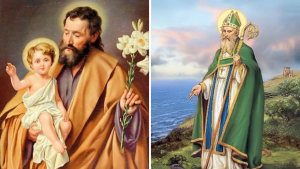The liturgy of the Lenten Season dominates the month of March. Most feast days have been moved to other times of the year except for two.
I am always pleased when the feasts of St. Patrick and St. Joseph roll yearly. St. Joseph is especially dear to the Italian people, who celebrate him with festive meals. Patrick, of course, is specially reverenced by my own people, the Irish, who celebrate him with parades. Families are a huge part of both traditions. Though separated by four centuries and though hailing from extremely different cultures, Patrick and Joseph have a great deal in common, spiritually speaking.
Let’s consider Patrick first. A Roman Briton, born in the early fifth century, Patrick, while still a young man, was kidnapped by raiders and brought to Ireland, where he lived the brutal life of a slave. How often he must have wept. How often he must have cried out to God, wondering how he could have been so thoroughly abandoned. After six years in Ireland, Patrick finally managed to escape and return home. Some accounts have it that he then sojourned in France, doing his theological studies there and becoming ordained as a priest.
Looking at his early life , one would readily conclude that still youthful Fr. Patrick would never want to journey again to the place where his life had hit rock bottom. Instead, he decided to go back to Ireland in order to carry the Gospel to those who had enslaved and persecuted him. How can we explain this?
We have to appreciate that Patrick, like all of the saints, saw his life as a part in a drama that God was directing and producing. He appreciated that the whole awful experience of being a slave was not simply dumb suffering, but was, strangely, a preparation for the work that God had for him. During those terrible years, he learned a great deal about the history, topography, and language of the Irish; he came, perhaps, to love some of their lore and religious customs. Patrick came to understand the “enemy” culture from the inside and hence was able, with special skill and creativity, to engage it.
Now let us look at St. Joseph. Every episode of his life recounted in the Bible is a crisis. He discovers, to his dismay, that the woman he loved and to whom he was betrothed to marry, was pregnant. How lost and confused he must have been. Instead, he resolved, undoubtedly with a broken heart, to divorce her quietly. But then the angel of the Lord appeared in a dream and explained the mysterious pregnancy. Placing his own fears and preoccupations to one side, Joseph understood what was happening in the context of God’s will and he took Mary as his wife.
Next, discovering that the child was in mortal danger, Joseph took mother and baby on a perilous journey, across hundreds of miles of trackless desert, to an unknown country, an unknown village, an unknown people. Now add to it the keen sense that your baby is being pursued by agents of King Herod intent upon his murder. But Joseph went because God had commanded him.
Finally, we hear of Joseph desperately seeking his lost twelve-year-old son. Speak to any parent who has gone through a similar experience—looking for a child who has wandered away or been taken—and you will hear of a fear beyond measure. So we can fully understand Mary’s reaction when, having finally discovered Jesus among the doctors in the Temple: “Son, why have you done this to us? Your father
and I have been looking for you with great anxiety?” And they received that devastatingly understated response: “Why were you looking for me? Did you not know I must be in my Father’s house?” Quietly taking the child home, Joseph once more put aside his human feelings and trusted in the purposes of God. The little we know about Joseph is that he experienced heartbreak, fear unto death, and a parent’s deepest anxiety, but each time, he sensed what happened to him as God’s plan and not of a human nature.
The Church prominently recognizes both of these saints during Lent, and we can rejoice with a favorite saying of Monsignor Finn, “As they say in Dublin, MANGIA!”
—Deacon Jim Cowan, Sacred Heart Parish, Staten Island, NY.

